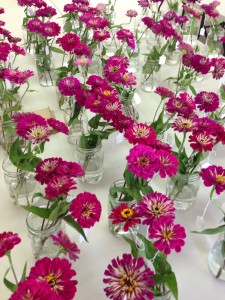 |
From left: 1. Great Lakes Chillwave Double IPA;
2. Widmer Brothers Old Embalmer; 3. Tallgrass 8-Bit;
4. New Belgium Rampant; 5. Samuel Adams Double Agent IPL.
Photo: F. Martin Ramin/The Wall Street Journal. |
No longer. Showcasing new and experimental breeds of hops, the latest pale ales offer a welcome change of pace: nuanced flavor.
Beer is made of four ingredients: water, grain, yeast and hops. Some styles are defined by how they balance those components—an Irish stout's mix, say, of mineral-rich water, tannic yeast and darkly roasted grain. Others showcase one player in particular. In a Belgian dubbel, it's a deep, fruity yeast. In IPAs, it's hops.
Brewers have used hops since as far back as the 15th century. The flowers of the humulus lupulus plant contain bitter acids packed with antimicrobial compounds that helped keep unpasteurized beer fresher longer. Until the Industrial Revolution, when new coal-fired kilns began to toast brewing grains light and clean, beers were dark and smoky—rich enough to temper the hops' bitter bite. But once beers lightened up, drinkers could finally taste the hops, and brewers liked to feature the best—especially a variety called Goldings, grown in the sea-breeze-tickled fields of Kent, England. The first to take to this new pale style was the British army brass in India, where the beers offered a floral, grassy, straw-hued taste of home. Thus: India pale ale.
When America's hops industry emerged in New York State and the Pacific Northwest, the new terroir produced coarser flavors. Some British drinkers complained that American strains like Clusters and Nuggets tasted like black currants. Beginning in the 1970s, pioneering American craft brewers, eager to tout local crops—and tickle palates fatigued by years of bland macro-brew—took to the new tastes with vigor, making their brews as hoppy as they could.
Now fatigue of a different sort has set in. Drinkers are tired of the bitterer-than-thou arms race, and hops breeders are listening. The latest IPAs aren't a taste of pastoral Britain or evergreen Oregon forests, but of the tropics.
That's due to new strains of so-called "high-oil" hops. Hop acids like humulone provide bitterness and preservative value, while oils contained in the plant give flavor and aroma—Citra's orange-soda-like thiol or the clove-like caryophyllene in Apollo.
You don't need a biochem degree to appreciate these hops, just a good thesaurus. Take the Mosaic variety, a galaxy of flavor. Born HBC369 on Jason Perrault's farm in Yakima Valley, Wash., Mosaic is a cross of Simcoe (notes of dried plum) with Nuggets (woodsy, herbal). Mr. Perrault tastes blueberry in this strain; I get a tropical fruit basket. Used in Odell's Woodcut 6 ale, it's apricots in syrup; in Samuel Adams's Latitude 48, it's guava nectar, oily and rich.
Working with small-crop, experimental breeds, little brewpubs like San Jose's Hermitage lead the way—keep a nose out for their satsuma- and tangerine-tinged Mandarina Bavaria. Indeed, batches often have to be small. Some hops go from code name to industry darling to rarity in a season. Citra took off in Sierra Nevada's Torpedo—the most popular IPA in the country—and then became nearly impossible for craft brewers to find. Knee Deep Brewing had to rename (and re-hop) their Citra IPA—it's now called, aptly, Hop Shortage.
So get them while you can: a fleeting, flickering burst of tropical sun in a northern winter.
Tasting Notes:
1. Great Lakes Chillwave Double IPA (9.4% ABV): Hop-of-the-moment Mosaic bursts through this beer like a splash of mango nectar. It comes on like fruit soda but finishes with an IPA's bracing bitter kick.
2. Widmer Brothers Old Embalmer (10.2% ABV): Oregon's Widmer has a long relationship with Yakima Valley hops growers, and often gets first dibs on experimental strains like John Haas's X-431, featured in this barley wine. The beer is strong, and its caramel sweetness complements the hops' notes of blood orange and grapefruit rind.
3. Tallgrass 8-Bit (5.2% ABV): Like a sweet-sour mojito, 8-Bit blossoms rich and juicy—pineapple and cactus fruit—but drifts off with a menthol-ish tickle into a cooling finish. Hot and cold, deep and bright, springtime in the desert.
4. New Belgium Rampant (8.5% ABV): A brash name for a bright and bubbly beer. Mosaic and Calypso hops provide fruity flavor—peach, pear, pluot, strawberry—but classically American-accented Centennials provides a tempering zest of candied lemon peel.
5. Samuel Adams Double Agent IPL (5.0% ABV): This "imperial lager" gets its juiciness from New Zealand-grown Nelson Sauvins hops. Named for Sauvignon Blanc and the star of the burgeoning Kiwi hops industry, this strain mimics the gooseberry fruit and sweet finish of cool-climate white wines.
















